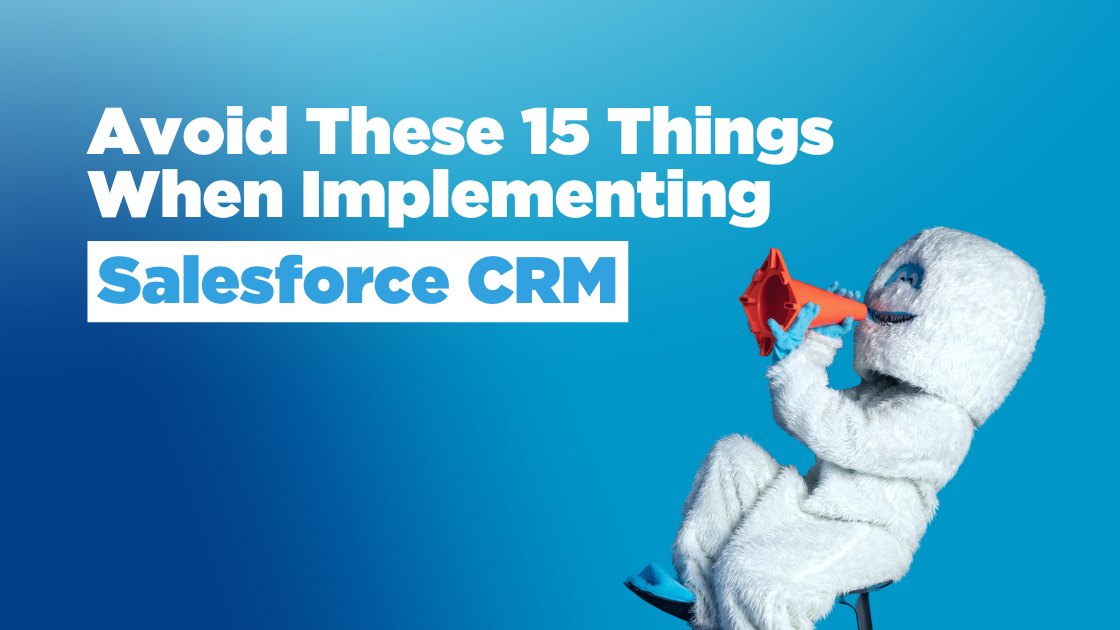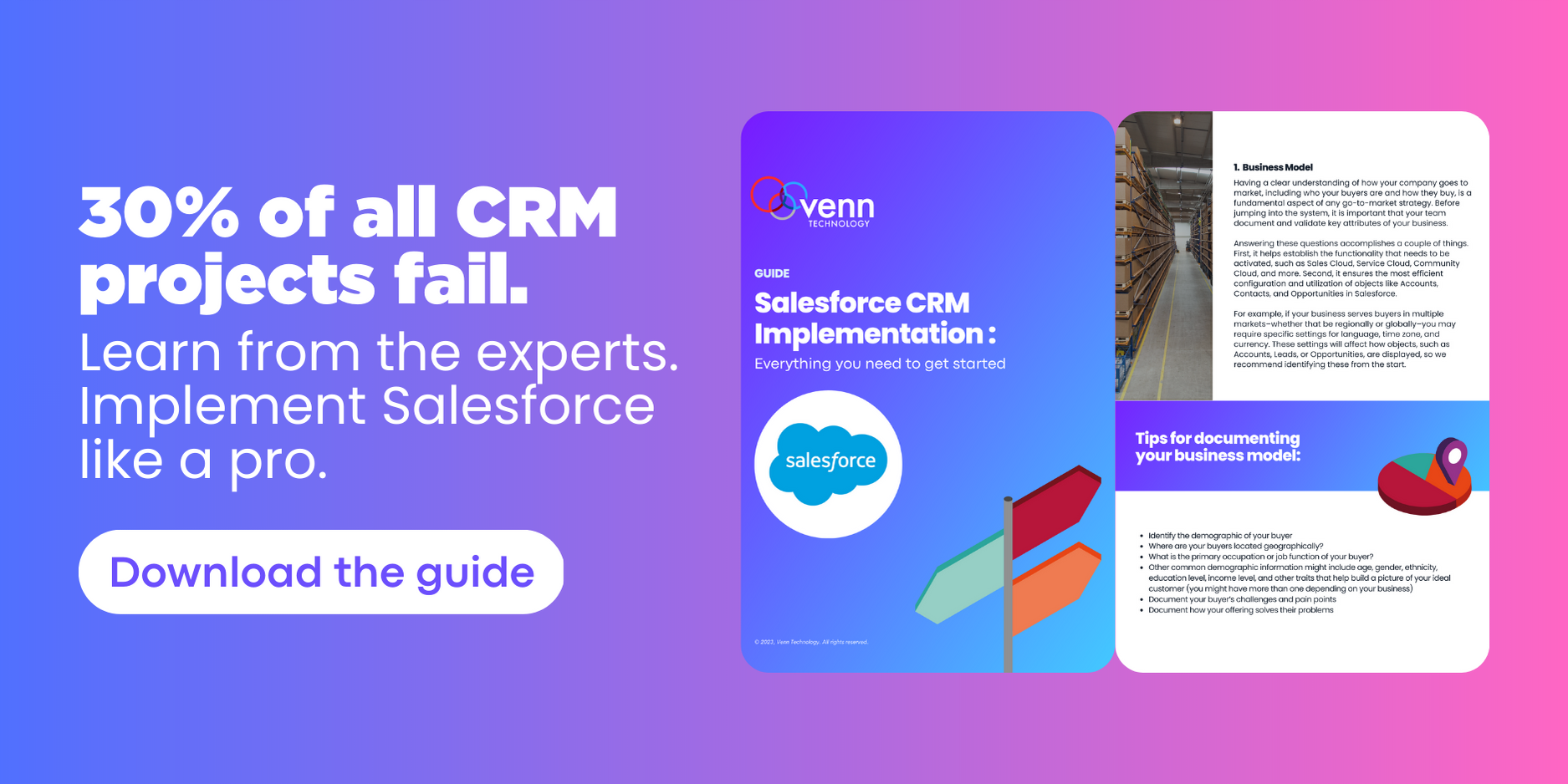Avoid These 15 Things When Implementing Salesforce CRM
Written byMelissa Bell

Updated on September 20, 2024
Any experienced Salesforce implementation partner follows a series of best practices, or things to always do, when implementing a new CRM system. On the flip side of that is a list of things to never do.
In this blog, we address some of the most common challenges businesses face in Salesforce implementations and how to avoid them.
Here are 15 common Salesforce implementation pitfalls:
1. Doing the implementation yourself.
If you buy a Porsche, you probably won’t take it to any old shop to perform maintenance on it. A Salesforce implementation should be treated no differently. Your business needs Salesforce implemented specifically for your workflows, and the Salesforce Platform has to be tuned to meet your specific needs to drive performance.
We routinely recommend working with an experienced Salesforce partner instead. Odds are, you didn’t get into business to implement Salesforce. The good news, lots of other people did.
2. Customizing the system too quickly.
Trying to do too much too soon and not focusing on the basics limits your ability to scale in the future. One of the biggest downfalls we see of any in-house implementation is configuring the solution for your business solely as it is today.
As your business grows, you need your CRM to grow with it. If the existing functionality isn’t designed to scale, you may be faced with having to rebuild pieces of functionality that drain time, resources, and a whole host of other implications to the business.
What's more, customizing the system too quickly can also lead to a lack of user adoption. If the CRM isn't intuitive and doesn't fit the way users work, they may be resistant to using it. This can result in user frustration and a decrease in productivity. By taking the time to properly analyze and understand user needs upfront, you can ensure the CRM is tailored to meet the individual needs of each user and increase the chances of user adoption.
Typically, Salesforce implementations take multiple months, sucking bandwidth from your team that is focusing on building the business. By bringing in experts, you reduce the time to implement and keep (most) of your team focused on what they’re good at.
This is especially true of organizations that don’t have staff with the Salesforce chops to back it up. Implementation partners are equipped to step in and fill the gaps between your processes and how they translate in the system.
3. Putting too much emphasis on technology and not enough on processes.
Simply put, this results in the same inefficiencies as before the implementation. Aligning the technology to your processes only works if you know what these are. Coming out of the sales cycle with Salesforce, it’s safe to say you know what the system can do, but is there alignment internally on how this new functionality will be used to enable your existing processes?It’s critical to have a clear understanding of your organization’s core business processes that need to be built out before modifying the system to enable them. Don’t be surprised if you decide to change your processes once you get more into the weeds of what the system can do–especially for those tasks your teams are doing manually now but can automate in Salesforce.
Configuring things in Salesforce is declarative, meaning it uses native functionality and requires zero programming. However, with so much flexibility at your fingertips, it’s easy to make mistakes that can hurt your business down the road. The Porsche wasn't built to perform on a rocky road, and neither should you!
4. Leaning too heavily on one department or function.
This can have downstream impacts on the whole business. Naturally, most teams turn to their sales department to understand how Salesforce should function once it’s up and running. Generally, we recommend that your project stakeholders are a mix of executives or upper management, middle managers, and end users across departments.
Although it’s likely many of your users are, in fact, salespeople, it’s critical that you engage other stakeholders in the business for input. This is especially true for departments that play a role in pre-sales and collections.
It’s not enough to understand how a Contact, Account, and Opportunity moves through the pipeline for a closed won deal. Documenting the full sales process, from when goods and services are sold to when the customer is invoiced, requires input cross-functionally. For example, how invoices are generated and what data is needed to expedite payment collection will probably come from the accounts payable team, not sales.The true power of the platform is being able to bridge gaps between teams and workflows across the whole system.
5. Having too many non-standard processes.
It can be tempting to build Salesforce to make it work for your most unique processes. It’s highly configurable and can be built to do just about anything; however, this can create limitations in how it interacts with other applications like your accounting or ERP systems.
6. Doing a Big Bang Implementation without enough discovery.
In this approach, all users of the system go live at the same time. We have seen this work well with smaller organizations with fewer users and relatively standard processes. For businesses with a lot of users and more complex workflows, we usually recommend chunking the project into iterative phases, or sprints.
We find that this minimizes the risk of something being overlooked in the process. When functionality is rolled out incrementally, it is easier to change and has less impact on the organization as a whole.
7. Not testing the system.
Testing is one of the most important steps in a Salesforce implementation. You need to test the system thoroughly before going live to ensure it meets your business requirements and that everything is working as expected.
Thoroughly documenting your processes and requirements in the Discovery phase isn’t enough to ensure what’s built will work.
And, since you know your processes best, it’s important to get teams involved in testing early and often. Overlooking testing inevitably leads to frustration and delays the project.
8. Working with bad data.
Data migration is one of the most important steps in a successful Salesforce implementation. You need to consider the data you want to transfer, how you will transfer it, and how you will clean and structure it.
Just because you have the data, that doesn’t necessarily mean it should be migrated to your new CRM. Continuing to operate with bad or duplicate data over figuring out what actually needs to be imported will get you the same results as before.
It’s also important to ask if there's a better way to collect and store clean data in Salesforce than previously before. For example, you might have a legacy system that collects a certain field in free form text, but the same could be accomplished in Salesforce using a pick list.
9. Forcing old processes to fit into the new system.
The reality is, most businesses buy Salesforce in part because of its flexibility at scale. As your team begins taking stock of your organization’s processes, be sure to note what isn’t working well.
Just because a process exists, does it really need to be replicated in Salesforce? Challenge teams to think about how processes could be improved. You may be surprised to find many parts of your most frustrating processes can be streamlined using standard Salesforce functionality.
10. Not dedicating enough time for training.
Training is essential for a successful Salesforce implementation. You need to have a plan for training users on how to use the system and how to get the most out of it.
If you are working with a partner, they can help you set expectations and develop realistic timelines based on the setup of your CRM. Some even offer training as part of their services.
Whether you plan to work with a partner or train in-house, creating a documented training plan for employees will increase adoption of the system and can be used for onboarding new employees.
11. Not including the subject matter experts on processes in the project.
In addition to organizing the project team around departments, it’s critical to bring in the people who know your processes best. Not only do they know how the current process works, but they can evangelize changes to it in the future.
12. Expecting the system to be a complete product when it goes into production.
As your business changes, so does the need for your processes and systems to support it. Going live with Salesforce will likely be the first of many iterations of your CRM. Conditioning your organization to provide feedback on the system and processes will be critical to making these ongoing enhancements.
Additionally, Salesforce releases new functionality and implements bug fixes every quarter. This means every three months you have the opportunity to streamline what you’re doing or make an even greater impact to your customers by providing more value. Even if you think your business or processes don’t need to change, the opportunity exists to win more business and improve the customer experience.
13. Getting lost in technical design.
One of the many benefits of Salesforce is how customizable it is.This makes it easy to get excited about the features that prompt your internal teams to say things like, “We need a button that does X…” or “We need a field that does Y…” The problem we see when teams place too much emphasis on what the process looks like on screen is that they don't think about that feature relative to the overall design.
In our experience, it’s better to start with asking, “What problem are we trying to solve?” Then you can figure out the best way to configure a specific field or where it makes sense to have a button.
14. Assigning someone in your organization the "Accidental Admin" hat.
This is one we see a lot. The “Accidental Admin” is usually an individual who is tech savvy with a lot of knowledge in how the system works but doesn’t have a professional background or formal training on Salesforce. It is really common in smaller organizations and can become problematic as they continue to grow.
Having access to Salesforce experts (through a partner) allows teams to focus on what they were hired to do. Unless your Admin is certified on Salesforce, it’s unlikely they were hired to manage it full-time.
Another reason to lean on a partner for ongoing maintenance and enhancements is agility and industry experience. They’re staffed and ready to tackle your next project, allowing your internal teams to get the functionality they need without disruption.
15. Getting too deep into automations with Flows or APEX
Salesforce Flows and the coding language APEX is powerful enough to handle some of the most complex processes for the likes of Fortune 500 companies. Our team has seen 100+ component Flows and APEX complex enough to make even the most seasoned Salesforce consultant’s head spin.
There are three primary challenges with implementing Flows and APEX:
- Identifying when in the process it makes sense to add automation
- APEX adds a ton of overhead to your deployment strategy.
- Too many Flows makes it easy to run into race conditions where other Flows should or should not trigger other things to run
If you are planning to self-implement, we recommend running your processes in Salesforce manually before incorporating automation. Let your people click through the process and provide feedback on the biggest chokepoints. Then, iteratively begin automating those using Flow. If the process is too complex for Flows, then it may be time to consider APEX for more custom development.
Bringing it all together
Any CRM implementation comes with its challenges. If your organization needs help planning for a Salesforce implementation, Venn Technology can help. A certified Salesforce partner since 2015, Venn Technology has helped organizations of all shapes and sizes implement, customize, and maintain their investment in the platform.


About the Author
Melissa Bell
Director of Sales & Marketing

